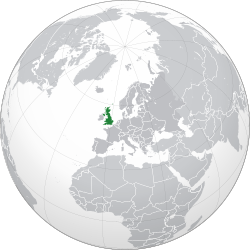
Back الأسلحة النووية والمملكة المتحدة Arabic যুক্তরাজ্যের পরমাণু অস্ত্র Bengali/Bangla Arsenal nucléaire du Royaume-Uni French Broń jądrowa Wielkiej Brytanii Polish Ядерное вооружение Великобритании Russian Ядерна програма Великої Британії Ukrainian
| United Kingdom | |
|---|---|
 | |
| Nuclear program start date | 10 April 1940 |
| First nuclear weapon test | 3 October 1952 |
| First thermonuclear weapon test | 15 May 1957 |
| Last nuclear test | 26 November 1991 |
| Largest yield test | 3 Mt (13 PJ) (28 April 1958) |
| Total tests | 45 detonations |
| Peak stockpile | 520 warheads (1970s) |
| Current stockpile | 225 warheads (2024)[1] |
| Maximum missile range | 12,000 kilometres (7,500 mi) (UGM-133 Trident II) |
| NPT party | Yes (1968, one of five recognised powers) |
| Nuclear weapons |
|---|
 |
| Background |
| Nuclear-armed states |
|
In 1952, the United Kingdom became the third country (after the United States and the Soviet Union) to develop and test nuclear weapons, and is one of the five nuclear-weapon states under the Treaty on the Non-Proliferation of Nuclear Weapons.
The UK initiated a nuclear weapons programme, codenamed Tube Alloys, during the Second World War. At the Quebec Conference in August 1943, it was merged with the American Manhattan Project. The British government considered nuclear weapons to be a joint discovery, but the American Atomic Energy Act of 1946 (McMahon Act) restricted other countries, including the UK, from access to information about nuclear weapons. Fearing the loss of Britain's great power status, the UK resumed its own project, now codenamed High Explosive Research. On 3 October 1952, it detonated an atomic bomb in the Monte Bello Islands in Australia in Operation Hurricane. Eleven more British nuclear weapons tests in Australia were carried out over the following decade, including seven British nuclear tests at Maralinga in 1956 and 1957.
The British hydrogen bomb programme demonstrated Britain's ability to produce thermonuclear weapons in the Operation Grapple nuclear tests in the Pacific, and led to the amendment of the McMahon Act. Since the 1958 US–UK Mutual Defence Agreement, the US and the UK have cooperated extensively on nuclear security matters. The nuclear Special Relationship between the two countries has involved the exchange of classified scientific data and fissile materials such as uranium-235 and plutonium. The UK has not had a programme to develop an independent delivery system since the cancellation of the Blue Streak in 1960. Instead, it purchased US delivery systems for UK use, fitting them with warheads designed and manufactured by the UK's Atomic Weapons Establishment (AWE) and its predecessor. Under the 1963 Polaris Sales Agreement, the US supplied the UK with Polaris missiles and nuclear submarine technology. The US also supplied the Royal Air Force and British Army of the Rhine with nuclear weapons under Project E in the form of aerial bombs, missiles, depth charges and artillery shells until 1992. Nuclear-capable American aircraft had been based in the UK since 1949, but the last US nuclear weapons were withdrawn in 2008.
In 1982, the Polaris Sales Agreement was amended to allow the UK to purchase Trident II missiles. Since 1998, when the UK decommissioned its tactical WE.177 bombs, the Trident has been the only operational nuclear weapons system in British service. The delivery system consists of four Vanguard-class submarines based at HMNB Clyde in Scotland. Each submarine is armed with up to sixteen Trident II missiles, each carrying warheads in up to eight multiple independently targetable re-entry vehicles (MIRVs). With at least one submarine always on patrol, the Vanguards perform a strategic deterrence role and also have a sub-strategic capability.
- ^ "Status of World Nuclear Forces". Federation of American Scientists. 29 March 2024. Retrieved 10 July 2024.